FNSBSD Alaska Native Education
(DRAFT)

ALASKAN
ATHABASCANS

Written by
Patricia H. Partnow
Illustrated
Jeanette Bailey
Carolee Pollock
Cover design by
Yvonne Merrill
Produced by
Indian Education Act Project
Anchorage School District
Under Grant #0969A
Part A, Title IV
PL 92-318
Revised Edition
June, 1985
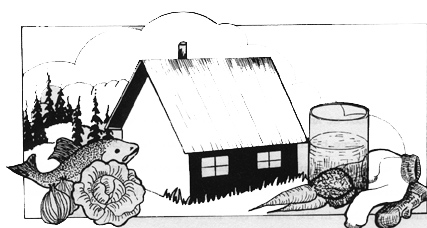
CHAPTER I
BASIC NEEDS
All human beings need certain things to
stay alive. You know what they are: food, air, water, clothing,
and shelter. All human beings need these things, but different
people get them in different ways. It is the different ways
that Alaska Natives have used to get their basic needs that
you will be studying. These ways are part of what we call
a culture.
Before learning about people in other
places or times, look at the way you fulfill your needs right
now in Anchorage. How do you get food, air, water, clothing,
and shelter? Where do the things you need come from? Could
your family get them if you were the only people living in
the area? If there were no town, stores, or money, could
you fulfill your basic needs?
Perhaps you can imagine how you would
survive: You would make use of the natural environment of
the area. You would get your food clothing, shelter, water,
and air from the plants, animals, minerals, and features
of the natural environment.
What is your natural environment? The
natural environment in Anchorage is not always easy to find.
You have to imagine this area without all its houses, roads,
buildings, bike trails, footbridges, water wells, playgrounds,
and lawns. These things are all part of the man-made environment
of Anchorage.
Lets look at Anchorage without its man-made
environment. It is an area with some birch trees, some spruce
and hemlock. There are swampy areas. There are marshy areas
where birds nest. There are clear streams flowing down from
the mountains, with salmon, and trout swimming up them in
the summer and fall. There is tundra on the hills above the
treeline. And there are many kinds of wildlife, such as moose,
bears, sheep, clams, fish and birds.
This natural environment is what the Tanaina
(also spelled Denaina) Athabascans found when they first
arrived in the Anchorage area a long time ago. It was from
this natural environment that they fulfilled their basic
needs.
When those early Tanainas came to Anchorage,
the first thing they had to do was learn about the environment.
They had to learn what resources were in it. They had to
know what time of year to get the resources. They had to
know where and how to get the resources. It took each person
many years to learn all those details. You'll be learning
a few of them in this unit.
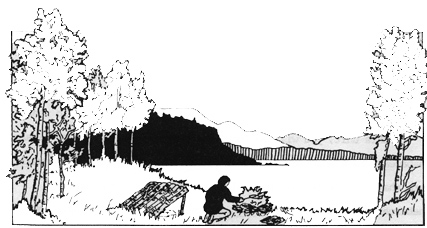
CHAPTER II
ADAPTATIONS
After the early Tanaina Athabascans In
this area got the things they needed to fulfill their basic
needs, the next step was to use those things. It takes a
lot of knowledge to use the natural environment well. For
instance, after they had found, tracked, and killed a moose.
the Tanainas needed to know how to butcher it. They needed
to know which parts could be used for food, which parts to
make tools, which parts could become clothes. They need to
know how to preserve the meat.
The ways in which people use or change
the things from their natural environment to meet a need
are called their adaptations to the natural environment.
One example of an adaptation to our natural environment is
a house. A house uses materials from the environment to protect
against the rain, snow, and cold. It helps keep people warm,
and so fulfills the basic need for shelter.
The early Athabascans made many adaptations
to their environment. And today, all Alaskans. both Athabascans
and non-Athabascans are still making and using adaptations.
Many of our adaptations today no longer meet basic needs.
Paved roads, for instance, are an adaptation to the need
to travel quickly in cars. But that is not a basic need.
In this unit, you will be looking at some
of the ways some Alaskan Athabascans have adapted to their
environments in the past. You will learn that, unlike the
way many Alaskans live today, the early Athabascans used
mostly their natural environment in adapting. You will learn,
too, that even today, many Athabascans prefer to live where
they can be close to the natural environment, adapting to
it in old and new ways.
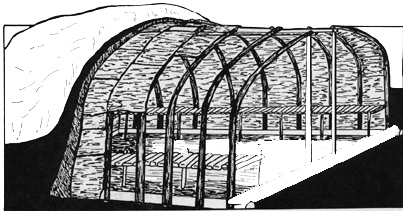
CHAPTER III
Athabascans
If you are an Athabascan Indian, you are
one of about 200,000 people in North America. There are more
Athabascans than any other American Indian group. In Alaska
alone there are about 6,400 Athabascans, and there are also
Athabascan groups in Canada, California, and the American
Southwest. But what does the word Athabascan mean?
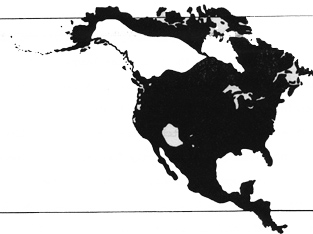
The word "Athabascan" is used
to talk about a group of languages which were once, thousands
of
years ago, the same language. Over the years people moved
away from each other and their languages started to become
different. At first, just the accents were different--something
like the difference between a Southern accent and an English
accent. But people were so far apart that they never talked
to each other, and slowly different
words took on different meanings,
or the words themselves changed. For Instance, the word for "gloves" became "gech" for
one group of people and "gis" for another group of people.
Through the years the differences between the two groups
became greater and greater until people in one area could
no longer understand people in another area. Whenever that
happens, we say that the two groups of people speak different
languages.
That is what happened to the
Athabascan language. Today there are eleven Athabascan languages
in
Alaska alone: Ahtna, Tanaina (also spelled Denaina), Holikachuk,
Koyukon, Upper Kuskokwim, Tanana, Tanacross, Upper Tanana,
Han, Kutchin (more correctly spelled "Gwich'in"), and Ingalik
(more correctly Deg Hit'an). There are other Athabascan languages
in Canada. And there are two well-known Athabascan languages
in the American Southwest: Apache and Navajo.
The word "Athabascan" is used to talk
about both the languages and the people who speak (or whose
ancestors spoke) that language. The name "Athabascan" originally
came from the large lake in Canada called "Lake Athabasca".
The lake was given its name by the Cree Indians, who lived
east of it. In Cree, "Athabasca" means "grass here and there",
and described the lake. The name was also used to talk about
the Indian groups that lived west of the lake.
You can see on the language map of Alaska
that the area inhabited by Athabascans is one of the largest
of the Native areas in the state. The area is all inland,
except for the part around Cook Inlet. Find the Athabascan
settlements on the map. You can see that most of them are
located on rivers, what needs can you think of that rivers
might help fulfill?

CHAPTER IV
UPPER TANANA ATHABASCANS
The map of Alaska shows eleven different
groups of Athabascan Indians speaking eleven different languages
in Alaska. You don't have time to learn about every group,
so you will concentrate on one group in this unit: the Upper
Tanana Athabascans. As you learn about that group, remember
that each Athabascan area is a little different, and so are
the customs of the people living in each area.
You will be reading a book called Tetlin
As I Knew It. It was written by Shirley Jimerson, an Upper
Tanana Athabascan who now lives in Anchorage but who grew
up in Tetlin. In her book, she describes the way life was
when she was a little girl, in the 1950's. Life changes for
people all over the world, and life has changed in the Tetlin
area too. Nowadays there are more stores, and snowmachines
and more people going to school than there were in the 1950's.
Nowadays men don't trap with their families as much. Instead,
they go with friends and leave the families in town so the
children can go to school. And nowadays more and more men
and women are working for money, instead of surviving from
the natural environment.
Life is different now from the way it
was when Shirley Jimerson was little. As you read, try to
find clues to the way life was different for Shirley than
for her mother and father when they were little.

CHAPTER V
THERES MORE TO CULTURE THAN BASIC NEEDS
You've learned a little bit about how
the Upper Tanana Athabascans adapted to fulfill their basic
needs in the area around Tetlin. But you've also learned
something else: you've learned some of what the life meant
to the people as they were busy getting their food, water,
clothing, and shelter. You've learned what they thought about
their hunting and trapping. These thoughts are another part
of their culture. In your mind, review what you've read and
try to think of all the feelings and thoughts Shirley Jimerson
expressed about her life.
Then think about your own life. You have
certain feelings and thoughts about it too. Most of us have
strong feelings about our birthdays, vacations, school, family,
and friends. These are all parts of the culture we live in.
Shirley Jimerson's book was written about
a time not too long ago when life was beginning to change
for the Upper Tanana Athabascans. The next book you'll read
is about a time longer ago than that. It is about a time
fifty years ago and more. In those days, people didn't live
in villages. They moved around throughout the year, even
more than Shirley's family did. They called a very big area
of land their home, and each camp they stopped in was home
too. And they knew the miles of land in between camps as
well as you know your own yard or playground.
This next book, called When People Meet
Animals, explores more of the cultures of some of the Athabascan
groups. It tells more about the feelings and thoughts the
people had about the things they did in fulfilling their
basic needs.
CHAPTER VI
AN UP-DATE - TANAINA (DENAINA) TERRITORY TODAY
At the beginning of our study of Athabascan
culture, you learned that the Tanaina (or Denaina) Athabascans
came to the Anchorage area long ago. At least 300 years ago,
perhaps longer, they first began living here.
Of course, Tanainas still live in the
Anchorage area. Many Tanainas live in Anchorage itself, while
others live in villages close to town. The closest one is
Eklutna, north of Anchorage near Eagle River and Chugiak.
Eklutna has been a winter village of the
Tanainas since they first came to this area. It is close
to Cook Inlet fishing resources. Eklutna flats plant resources,
and good sheep hunting areas. Eklutna was one of many settlements
which the Cook Inlet Tanainas used. Other Upper Inlet Tanainas
used the land in the Matanuska and Susitna Valleys, up and
down the Knik and Susitna River systems. They had villages
in all of those areas. The large and small lakes, including
Big Lake, Nancy Lake and Eklutna Lake were part of their
territory. The Upper Inlet Tanainas also used the land where
the city of Anchorage is now. The area at the mouth of Ship
Creek was at one time an important Tanaina fish camp.
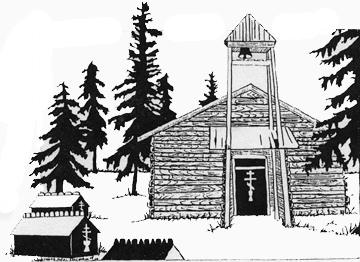
In the 1800's, Russians traveled up Cook
Inlet to Tanaina territory. They brought money and goods
to exchange for furs. They also brought something else--their
religion.
More than a hundred years ago, a Russian
Orthodox church was built in the village of Eklutna. That
church, along with a new one completed in 1963, still stands
today. Many Tanainas belong to the Russian Orthodox faith.
In the late 1800's and early 190O's, many
Tanainas trapped for furs and sold the furs to traders. They
used the money they got to buy some items of food, clothing,
and tools. They still used many of the old skills and knowledge
of their natural environment. And they still hunted for most
of their food. Even so, they had adapted to a new way of
life which used money.
Then in 1914 the Alaska Railroad was begun.
This was to run from Seward to Fairbanks, and it cut right
through the Tanaina area. Many Upper Inlet Tanainas worked
on building the railroad. Eklutna itself became one of the
railroad stations along the route. The people living there
could now easily get the goods they wanted from other parts
of Alaska and the lower 48. They had winter jobs on the railroad
close to their homes. They fished commercially during the
summer months. Their fishing sites were the same ones they
had used before the new town of Anchorage was started. In
fact, some of these sites on Fire Island and Point Possession
have been in the same families for 100 years.
Soon after the railroad was built, a school
to train people for jobs was started in Eklutna. Many Tanainas
got training to work in the new town of Anchorage. But new
jobs meant that people didn't have as much time for hunting
and fishing as they had in the past. Many people had to buy
most of their food and clothing. They had adapted to still
another way of life.
In the 1930's, there was another change
in the Upper Inlet Tanaina territory. During that time a
number of settlers came to the Matanuska Valley from the
mid-western part of the United States. These settlers cleared
land. They built farms in the territory that had been Tanaina
land. With some of the hunting and trapping areas now gone,
even more Tanainas moved further south to Anchorage where
they could find jobs.
In the early 1950's a tunnel was built
through the mountain from Eklutna Lake. This brought water
to a power plant which provided electricity to the Anchorage
area. It also provided jobs for some village people.
Today, most adults from Eklutna work in
the Anchorage area. Some of the older people still fish commercially
for a living. Their children go to local schools. People
buy most of their food and clothes in stores.
Yet something still remains of the older
culture. Parents and grandparents know a lot about the area
and its natural resources. Some of them can recall the old
ways of adapting to the environment, and some of the old
beliefs about the environment. Many people still use the
natural resources in fulfilling some of their basic needs.
They hunt moose and ducks, pick berries, and fish for some
of their food and money. They still feel that the land and
its creatures are to be respected and thanked for providing
for them.
Introduction
ANE Curriculum
Overview
Unit Overview
Athabascan
Art Sampler
OCR SCANNED MATERIAL